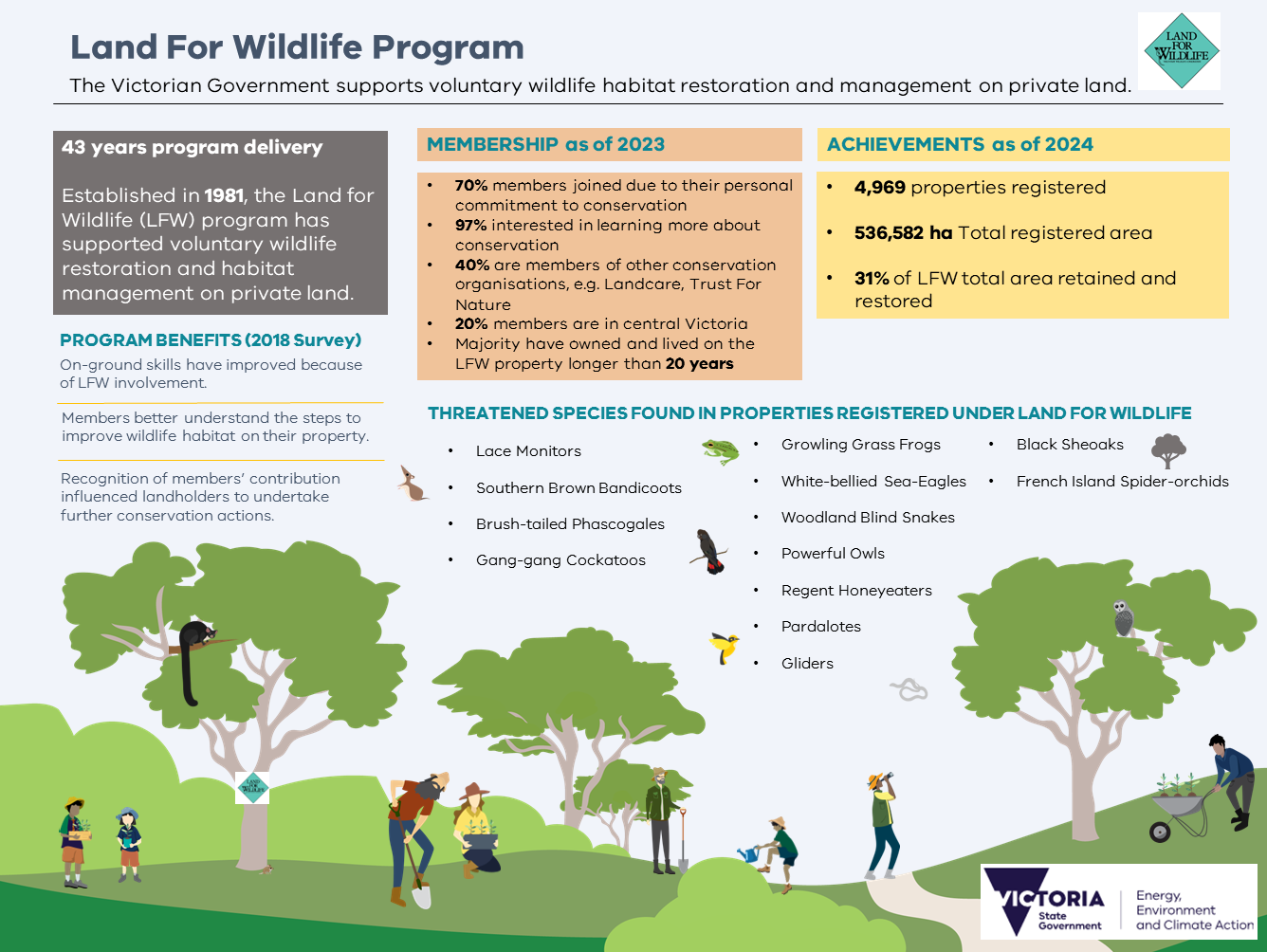Overview
Land For Wildlife is a voluntary wildlife conservation program which acknowledges and recognises private landowners who are managing and or restoring habitat for wildlife on their property.
The Land For Wildlife community make a significant contribution to native biodiversity conservation. They are actively involved in protecting and restoring habitat on their own land. Approximately 5,000 properties (comprising 536,000 ha of private land) are currently registered across the state.
Land For Wildlife membership
Free. There are no fees. The program recognises the significant contribution being made by landholders.
Voluntary. Landholders make a personal commitment to the scheme. They may withdraw at any time if they wish.
Free of legal binds. Land For Wildlife status doesn't alter the legal status of a property in any way. It does not convey the right of public access (for hunting or any other purpose) or make the area an official wildlife sanctuary prohibiting hunting all year.
Inclusive. Farms, bush blocks, parks, school grounds, golf-courses, municipal reserves, cemeteries, scout and youth camps, tourist enterprises, Commonwealth land, prisons, industrial land; small and large properties, are all eligible.
Technical Notes. Access to the Land For Wildlife Technical Notes (PDF, 5.3 MB) detailed information to support landholders protect wildlife on their property, ranging from habitat corridor creation to specific species information.
Sign. A Land For Wildlife sign is issued to the "registered landholder", to be displayed at the property. It belongs to the Land for Wildlife program. The landholder shall return the sign if the land is sold or the landholder membership ceases.
The Land For Wildlife was established in Victoria in 1981. It started as a community partnership between the Victorian government and Bird Observers Club (now Birdlife Australia). The program is one of the longest running government programs in Victoria providing voluntary, non-binding conservation agreements with landholders.
The Land For Wildlife Program has been delivered in other States and Territories of Australia and New Zealand since 1990, under a voluntary agreement with the State of Victoria.
Property qualifications
To be registered with Land For Wildlife, the following eligibility requirements need to be met.
The property must:
- be more than 1 hectare or 2.47 acres in size
- have more than 10% native vegetation as wildlife habitat
- be connected to a natural wildlife corridor, and
- be located outside of urban developed areas, or away from areas with high density residential, commercial, or road infrastructure.
Landholders will need to demonstrate how they will manage the property for nature conservation or how they plan to integrate nature conservation with land management objectives. The Land For Wildlife status of the property will be retained so long as nature conservation objectives are upheld.
If the property changes ownership, then the new owners need to re-apply.
Land For Wildlife is responsive to the needs of landholders and recognises that each landholder will have a different capacity to participate in the scheme.
If you need help in restoring native vegetation, please contact your nearest Landcare Group or the Bushbank Program for more information.
Register your property
Complete the application form and submit via email:
Land for Wildlife application form.doc (DOCX, 196.8 KB)
Land for Wildlife application form.pdf (PDF, 67.9 KB)
We will contact you after we receive your application.
Land for Wildlife Coordinator
Department of Energy, Environment and Climate Action
LFW@deeca.vic.gov.au
43 years program delivery
Established in 1981, the Land for Wildlife (LFW) program has supported voluntary wildlife restoration and habitat management on private land.
Program benefits
- On-ground skills have improved because of LFW involvement
- Members better understand the steps to improve wildlife habitat on their property
- Recognition of members’ contribution influenced landholders to undertake further conservation actions.
Membership as of 2023
- 70% members joined due to their personal commitment to conservation
- 97% interested in learning more about conservation
- 40% are members of other conservation organisations, e.g. Landcare, Trust For Nature
- 20% members are in central Victoria
- Majority have owned and lived on the LFW property longer than 20 years
Achievements as of 2024
- 4,969 properties registered
- 536,582 ha Total registered area
- 31% of LFW total area retained and restored
Threatened species found in properties registered under Land For Wildlife
- Lace Monitors
- Southern Brown Bandicoots
- Brush-tailed Phascogales
- Gang-gang Cockatoos
- Growling Grass Frogs
- White-bellied Sea-Eagles
- Woodland Blind Snakes
- Powerful Owls
- Regent Honeyeater
- Pardalotes
- Gliders
- Black Sheoaks
- French Island Spider-orchids
Page last updated: 01/10/24
